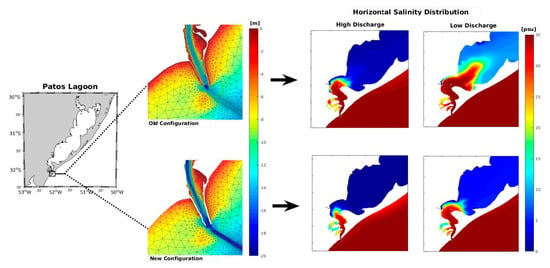Impact of Jetty Configuration Changes on the Hydrodynamics of the Subtropical Patos Lagoon Estuary, Brazil
Abstract
1. Introduction
2. Numerical Model
2.1. Model Description
2.2. Model Grid
2.3. Initial and Boundary Conditions
2.4. Calibration and Validation
2.5. Data Analysis
3. Results
3.1. Hydrodynamics
3.1.1. High Discharge Simulation
3.1.2. Low Discharge Simulations
3.2. Alterations in Saltwater Distribution
3.2.1. High Discharge Simulation
3.2.2. Low Discharge Simulation
3.3. Changes in Salinity Stratification at the Mouth of the Estuary
4. Discussion
5. Conclusions
Supplementary Materials
Author Contributions
Funding
Acknowledgments
Conflicts of Interest
References
- Adger, W.N.; Hughes, T.P.; Folke, C.; Carpenter, S.R.; Rockstrom, J. Social-Ecological Resilience to Coastal Disasters. Science 2005, 309, 1036–1039. [Google Scholar] [CrossRef]
- Prumm, M.; Iglesias, G. Impacts of port development on estuarine morphodynamics: Ribadeo (Spain). Ocean Coast. Manag. 2016, 130, 58–72. [Google Scholar] [CrossRef]
- Zhao, J.; Guo, L.; He, Q.; Wang, Z.B.; Maren, D.S.V.; Wang, X. An analysis on half centurry morphological changes in the Changjiang Estuary: Saptial variability under natural processes and human intervention. J. Mar. Syst. 2018, 181, 25–36. [Google Scholar] [CrossRef]
- Braverman, M.S.; Acha, E.M.; Gagliardini, D.A.; Rivarossa, M. Distrubution of Whitemouth croaker (Micropoginias furnieri, Desmarest 1823) larvae in the Rio de La Plata estuarine front. Estuar. Coast. Shelf Sci. 2009. [Google Scholar] [CrossRef]
- Salvador, N.L.A.; Muelbert, J.H. Environmental variability and body condition of Argentine menhaden larvae, Brevoortia pectinata (Jenyns, 1842), in estuarine and coastal waters. Estuaries Coasts 2019, 42, 1654–1661. [Google Scholar] [CrossRef]
- Abreu, P.C.; Odebrecht, C.; Niencheski, L.F. Nutrientes Dissolvidos. In O Estuário da Lagooa dos Patos: Um século de Transformações; Seeliger, U., Odebrecht, C., Eds.; FURG: Rio Rrande, Brazil, 2010; 180p, ISBN 978-85-7566-144-4. [Google Scholar]
- Able, K.W. A re-examination of fish estuarine dependence: Evidence for connectivity between estuarine and ocean habitats. Estuar. Coast. Shelf Sci. 2005, 64, 5–17. [Google Scholar] [CrossRef]
- Sheaves, M.; Baker, R.; Nagelkerken, I.; Connolly, R.M. True value of estuarine and coastal nurseries for fish: Incorporating complexity and dynamics. Estuaries Coasts 2015, 38, 401–414. [Google Scholar] [CrossRef]
- Ghashemizadeh, N.; Tajziehchi, M. Impact of Long Jetty on Shoreline Evaluation (Case Study: Eastern Coast of Bandar Abbas). J. Basic Appl. Sci. Res. 2013, 1256–1266. [Google Scholar]
- Azarmsa, S.A.; Esmaeili, M.; Khaniki, A.K. Impacts of Jetty construction on the wave heights of theKiashahr lagoon. Aquat. Ecosyst. Health Manag. 2009, 12, 358–363. [Google Scholar] [CrossRef]
- Yuk, J.H.; Aoki, S. Impact of Jetty construction on the current and Ecological Systems in the Estuary with a Narrow Inlet. J. Coast. Res. 2007, 784–788. [Google Scholar]
- Martelo, A.F.; Trombetta, T.B.; Lopes, B.V.; Marques, W.C.; Moller, O.O. Impacts of dredging on the hydromorphodynamics of the Patos Lagoon estuary, southern Brazil. Ocean Eng. 2019, 188. [Google Scholar] [CrossRef]
- Esteves, L.S.; Da Silva, A.R.P.; Arejano, T.B.; Pivel, M.A.G.; Vranjac, M.P. Coastal Development and Human Impacts Along the Rio Grande do Sul Beaches, Brazil. Journal of Coastal Research SI 35. In Proceedings of the Brazilian Symposium on Sandy Beaches, Morphodynamics, Ecology, Uses, Hazards and Management, Itajaí, Brazil, 3–6 September 2003; pp. 548–556, ISSN 0749-0208. [Google Scholar]
- Silva, P.D.; Lisboa, P.V.; Fernandes, E.H. Changes on the fine sediment dynamics after the Port of Rio Grande expansion. Adv. Geosci. 2015, 39, 123–127. [Google Scholar] [CrossRef]
- Lisboa, P.V.; Fernandes, E.H. Anthropogenic influence on the sedimentary dynamics of a sand spit bar, Patos Lagoon Estuary, RS, Brazil. J. Integr. Coast. Zone Manag. 2015, 15, 35–46. [Google Scholar] [CrossRef]
- Kjerfve, B.; Magill, E.K.E. Comparative oceanography of coastal lagoons. In Estuarine Variability; Wolfe, D.A., Ed.; Academic Press: New York, NY, USA, 1986; pp. 63–81. [Google Scholar]
- Castelão, R.M.; Moller, O.O. A modeling study of Patos Lagoon (Brazil) Flow response to idealized wind and river discharge dynamical analysis. Braz. J. Oceanogr. 2006, 54, 1–17. [Google Scholar] [CrossRef]
- Moller, O.O.; Castello, J.P.; Vaz, A.C. The Effect of river discharge and winds on the interannual variability of the Pink Shrimp Farfantepeneaus paulensis Production in Patos Lagoon. Estuaries Coasts 2009, 787–796. [Google Scholar] [CrossRef]
- Fernandes, E.H.L.; Dyer, K.R.; Moller, O.O.; Niencheski, L.F.H. The Patos Lagoon hydrodynamics during El Niño event (1998). Cont. Shelf Res. 2002, 22, 1699–1713. [Google Scholar] [CrossRef]
- Garcia, A.M.; Vieira, J.P.; Winemiller, K.O. Effects of 1997-1998 El-Niño on the dynamics of the shallow-water fish assemblage of the Patos Lagoon Estuary (Brazil). Estuar. Coast. Shelf Sci. 2003, 57, 489–500. [Google Scholar] [CrossRef]
- Moller, O.O.; Castaing, P.; Salomon, S.; Lazure, P. The Influence of Local and Non-local Forcing Effects on the Subtidal Circulation of Patos Lagoon. Estuaries 2001, 24, 297–311. [Google Scholar] [CrossRef]
- Fernandes, E.H.L.; Tapia, I.M.; Dyear, K.R.; Moller, O.O. The attenuation of tidal and subtidal oscillations in the Patos Lagoon Estuary. Ocean Dyn. 2004, 54, 348–359. [Google Scholar] [CrossRef]
- Fernandes, E.H.L.; Dyer, K.R.; Moller, O.O. Spatial Gradients in Flow of Southern Patos Lagoon. J. Coast. Res. 2005, 21, 759–769. [Google Scholar] [CrossRef]
- Moller, O.O.; Fernandes, E.H.L. Hidrologia e Hidrodinâmica. In O Estuário da Lagoa dos Patos: Um século de Transformações; Seeliger, U., Odebrecht, C., Eds.; FURG: Rio Grande, Brazil, 2010; pp. 17–27. ISBN 978-85-7566-144-4. [Google Scholar]
- Marques, W.C.; Monteiro, I.O.; Fernandes, E.H. Numerical modeling of Patos Lagoon plume, Brazil. Cont. Shelf Res. 2009, 29, 556–571. [Google Scholar] [CrossRef]
- Marques, W.C.; Fernandes, E.H.L.; Rocha, L.A.O. Straining and advection contributions to the mixing process in the Patos Lagoon estuary, Brazil. J. Geophys. Res. 2011, 115, C03016. [Google Scholar] [CrossRef]
- Seiler, L.M.N.; Fernandes, E.H.L.; Martins, F.; Abreu, P.C. Evolution of hydrologic influence on water quality variation in a coastal lagoon through numerical modeling. Ecol. Model. 2015, 314, 44–61. [Google Scholar] [CrossRef]
- TELEMAC 3D Model Information. Available online: www.opentelemac.org (accessed on 16 September 2020).
- Hervouet, J.M. Hydrodynamics of Free Surface Flows: Modeling with the Finite Element Method; Wiley: Chichester, UK, 2007. [Google Scholar]
- Vaz, A.C.; Möller, O.O.; Almeida, T.L. Análise quantitativa da descarga dos rios afluentes da Lagoa dos Patos. Atlântica 2006, 28, 13–23. [Google Scholar]
- Discharge Data. National Water Agency. Available online: http://www.ana.gov.br (accessed on 16 September 2020).
- Salinity and Temperature Data. Hybrid Model Coordinate Oceanic. Available online: https://hycom.org/ (accessed on 16 September 2020).
- Wind Data. European Center for Medium-Range Weather Forecasts. Available online: http://www.ecmwf.int (accessed on 16 September 2020).
- Marques, W.C.; Fernandes, E.H.L.; Moller, O.O. Straining and advection contributions to the mixing process of the Patos Lagoon coastal plume, Brazil. J. Geophys. Res. 2010, 115, C06019. [Google Scholar] [CrossRef]
- Walstra, L.; Van Rijn, L.; Blogg, H.; Van Ormondt, M. Evaluation of a Hydrodynamic Area Model Based on the Coast3d Data at Teignmouth 1999; Report TR121-EC MAST Project No. MAS3-CT97-0086; HR: Wallinford, UK, 2001; pp. D4.1–D4.4. [Google Scholar]
- Torrence, C.; Compo, G.P. A Practical guide of wavelet analyses. Bull. Am. Meteorol. Soc. 1998, 79, 61–79. [Google Scholar] [CrossRef]
- Freitas, P.P.; Menezes, M.O.B.; Schettini, C.A.F. Hydrodynamics and Suspended Particulate matter transport in a shallow and highly urbanized estuary: The Cocó Estuary, Fortaleza, Brazil. Rev. Bras. De Geofísica 2015, 33, 579–590. [Google Scholar] [CrossRef][Green Version]
- Odebrecht, C.; Abreu, P.C.; Moller, O.O., Jr.; Niencheski, I.F.; Proença, L.A.; Torgan, L.C. Drought Effect on Pelagic Properties in the shallow and turbid Patos Lagoon, Brazil. Estuaries 2005, 28, 675–685. [Google Scholar] [CrossRef]
- Azevedo, I.C.; Bordalo, A.A.; Duarte, P. Influence of freshwater inflow variability on the Douro estuary primary productivity: A modelling study. Ecol. Model. 2014, 272, 1–15. [Google Scholar] [CrossRef]
- Dyer, K.R. Estuarine flow interaction with topography—Lateral and longitudinal effects. In Estuarine Circulation; Neilson, B.J., Kuo, A., Brubaker, J., Eds.; Human Press: Tototowa, NJ, USA, 1989; pp. 39–59. [Google Scholar]
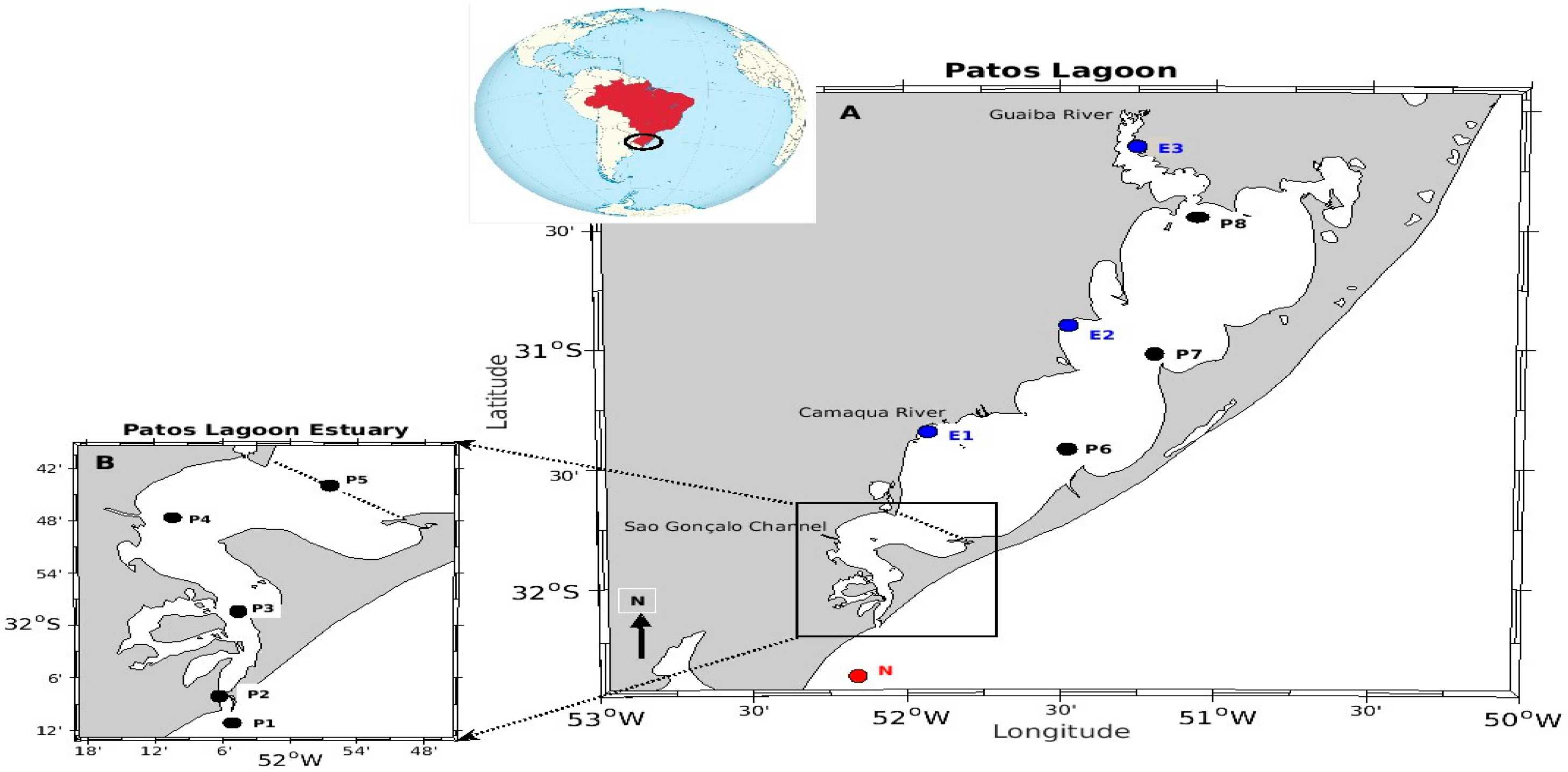
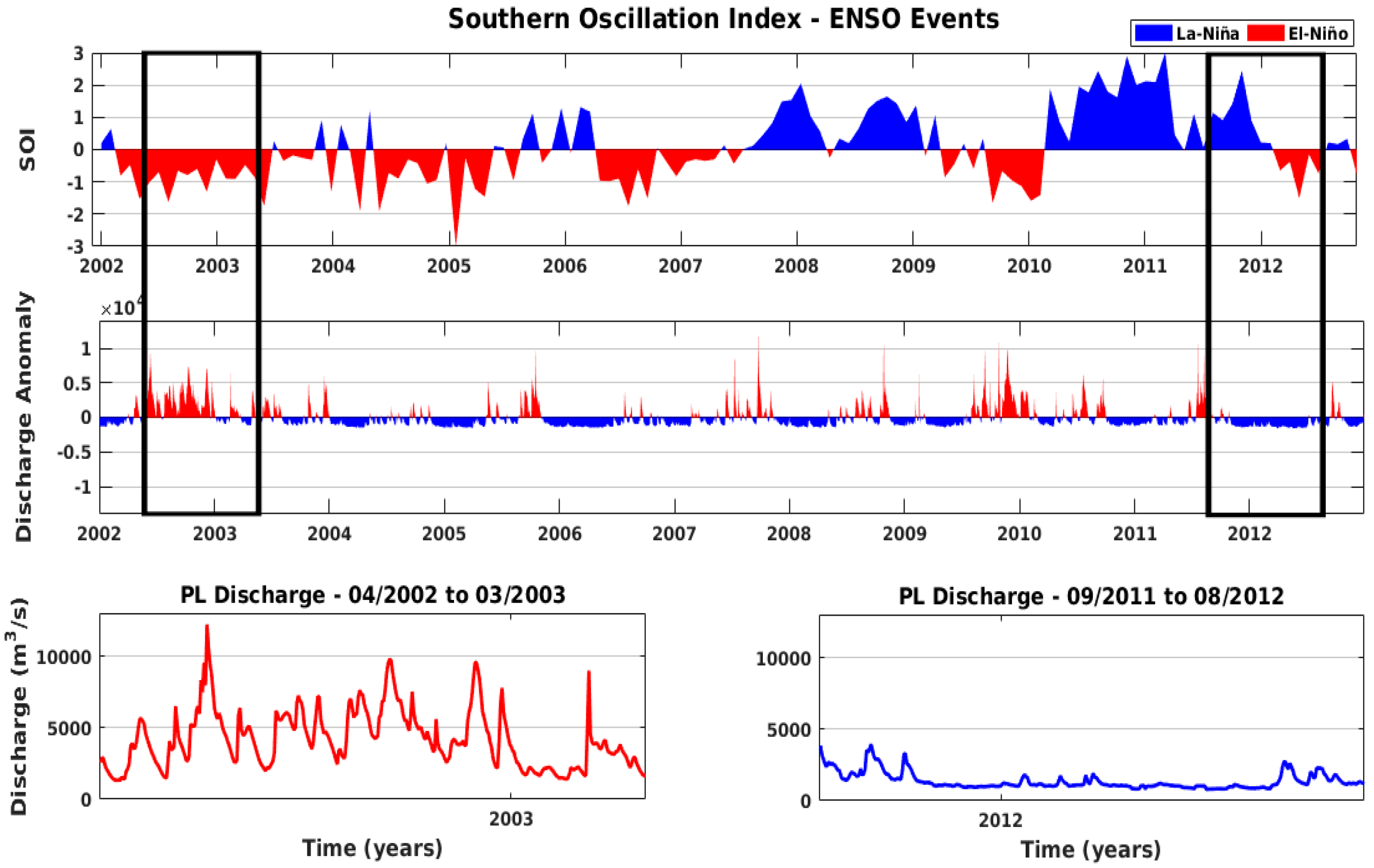
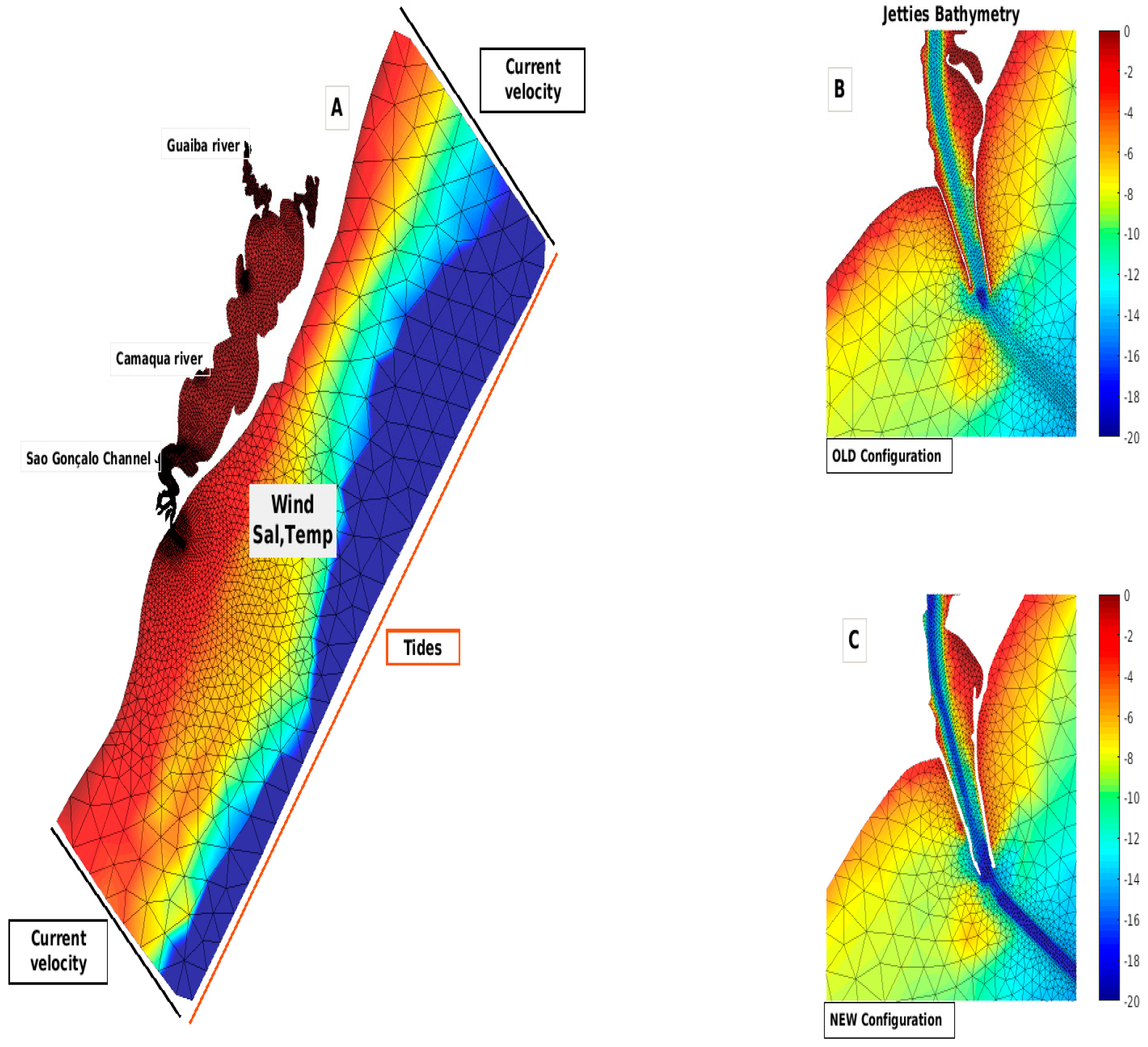
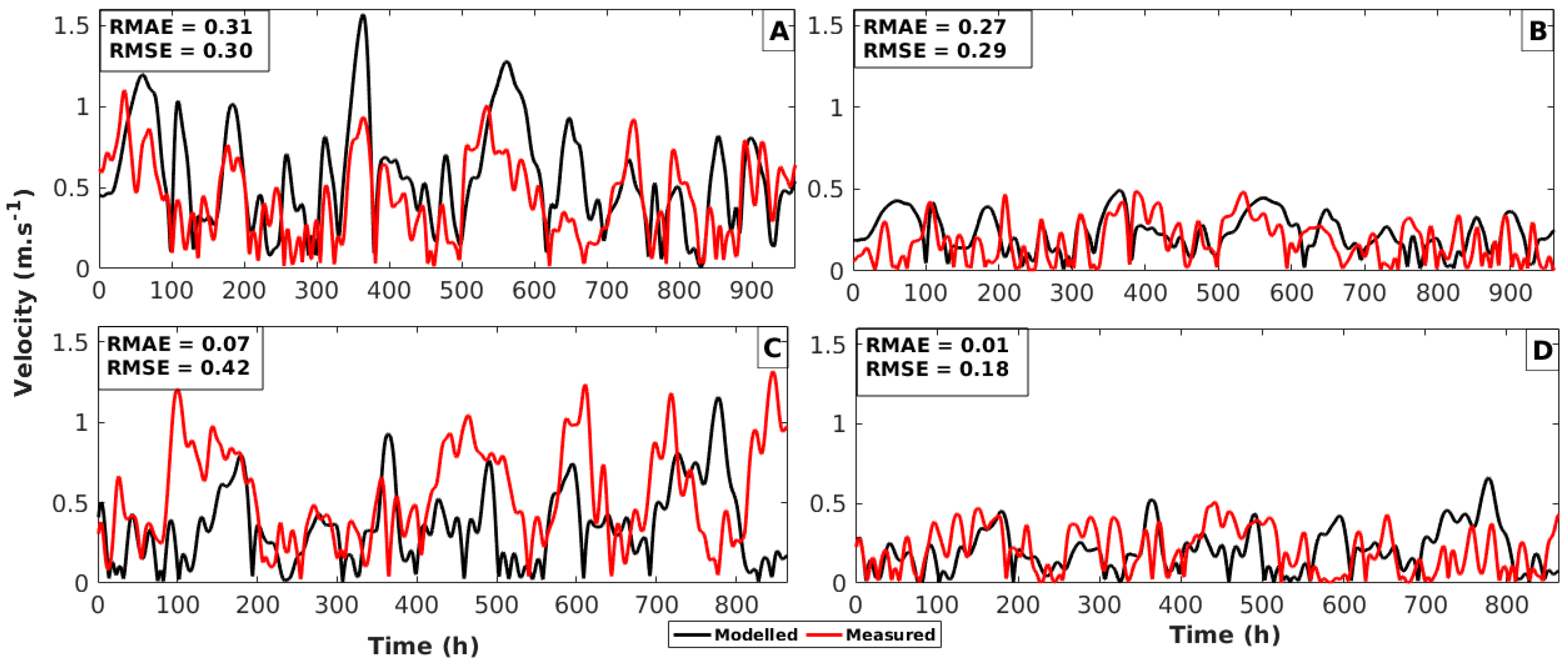
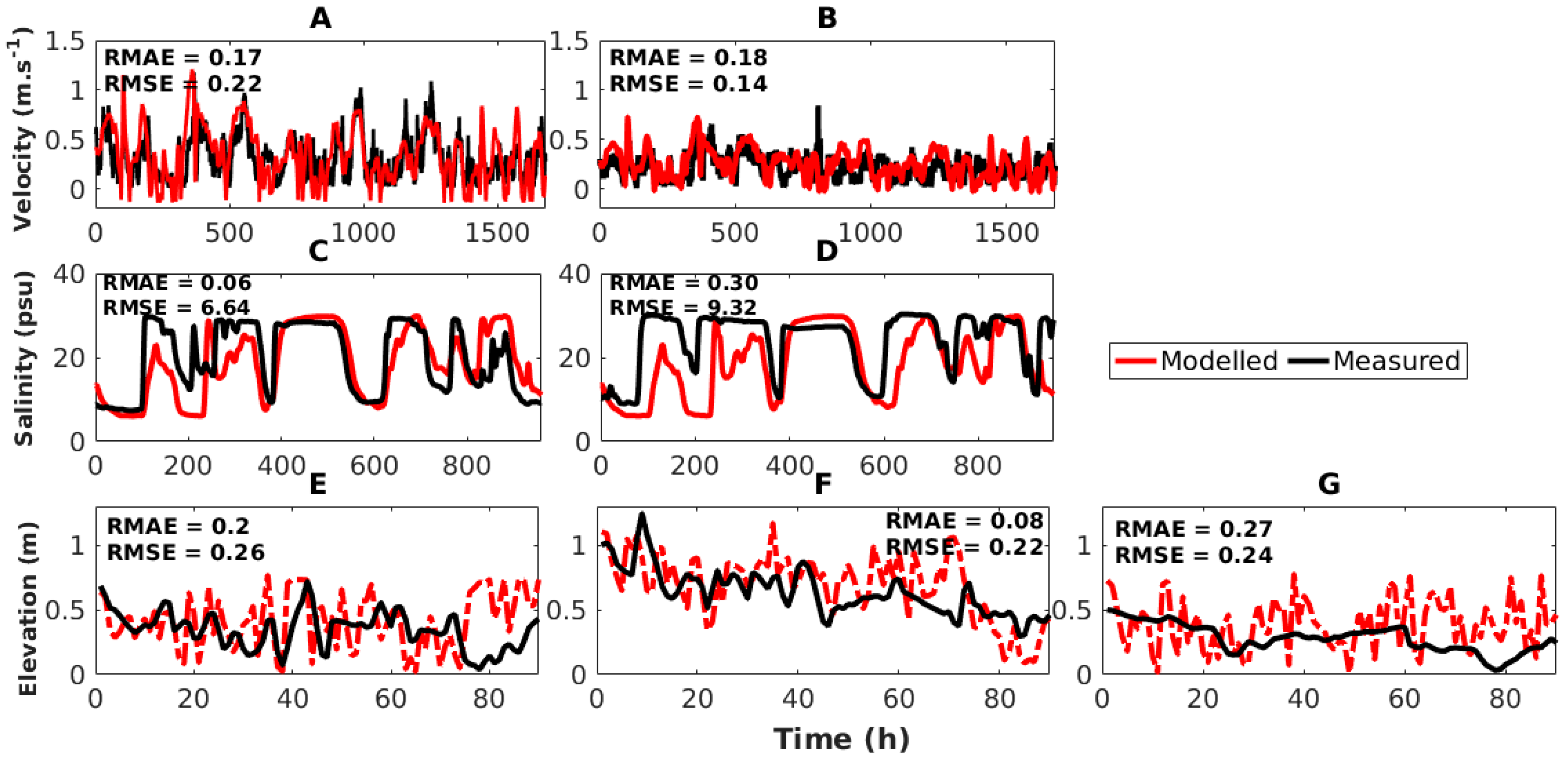
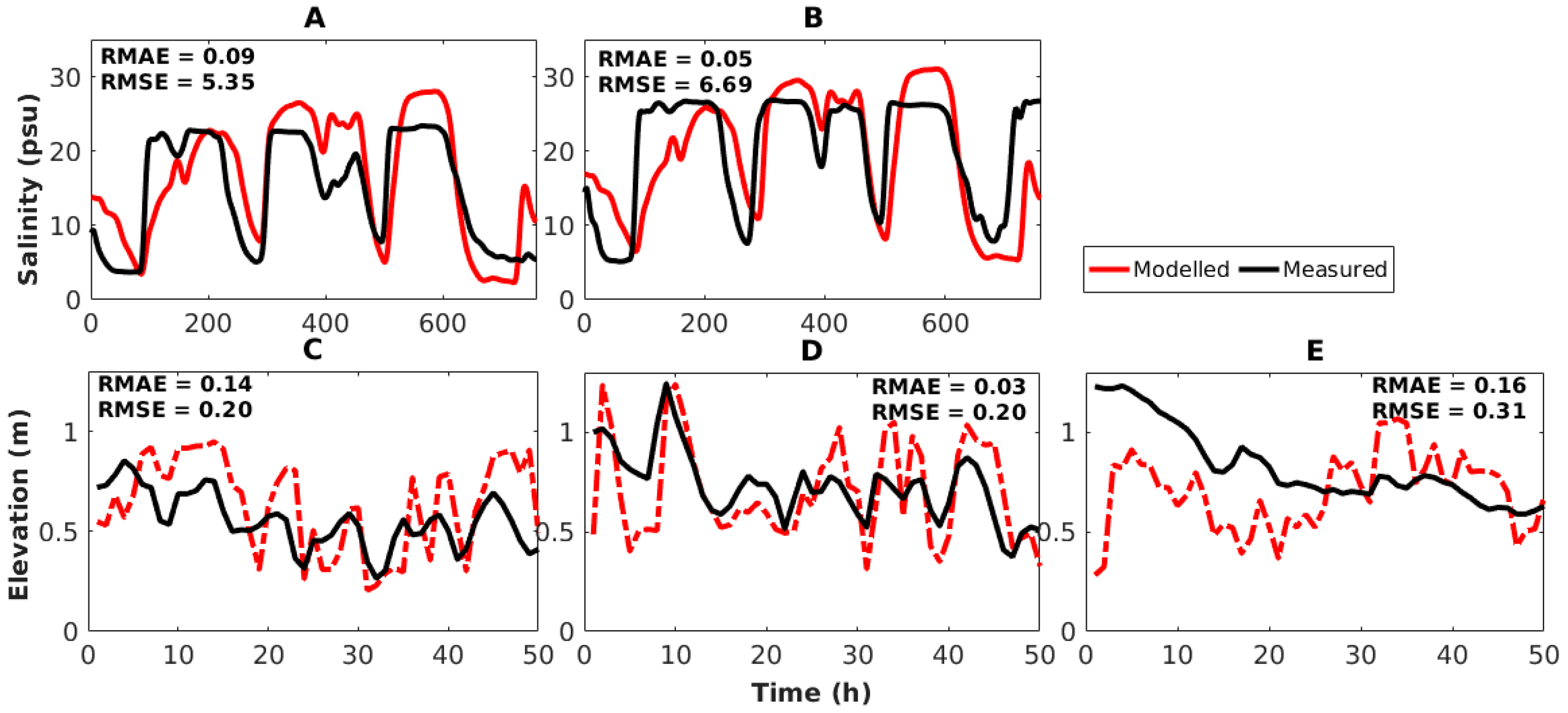

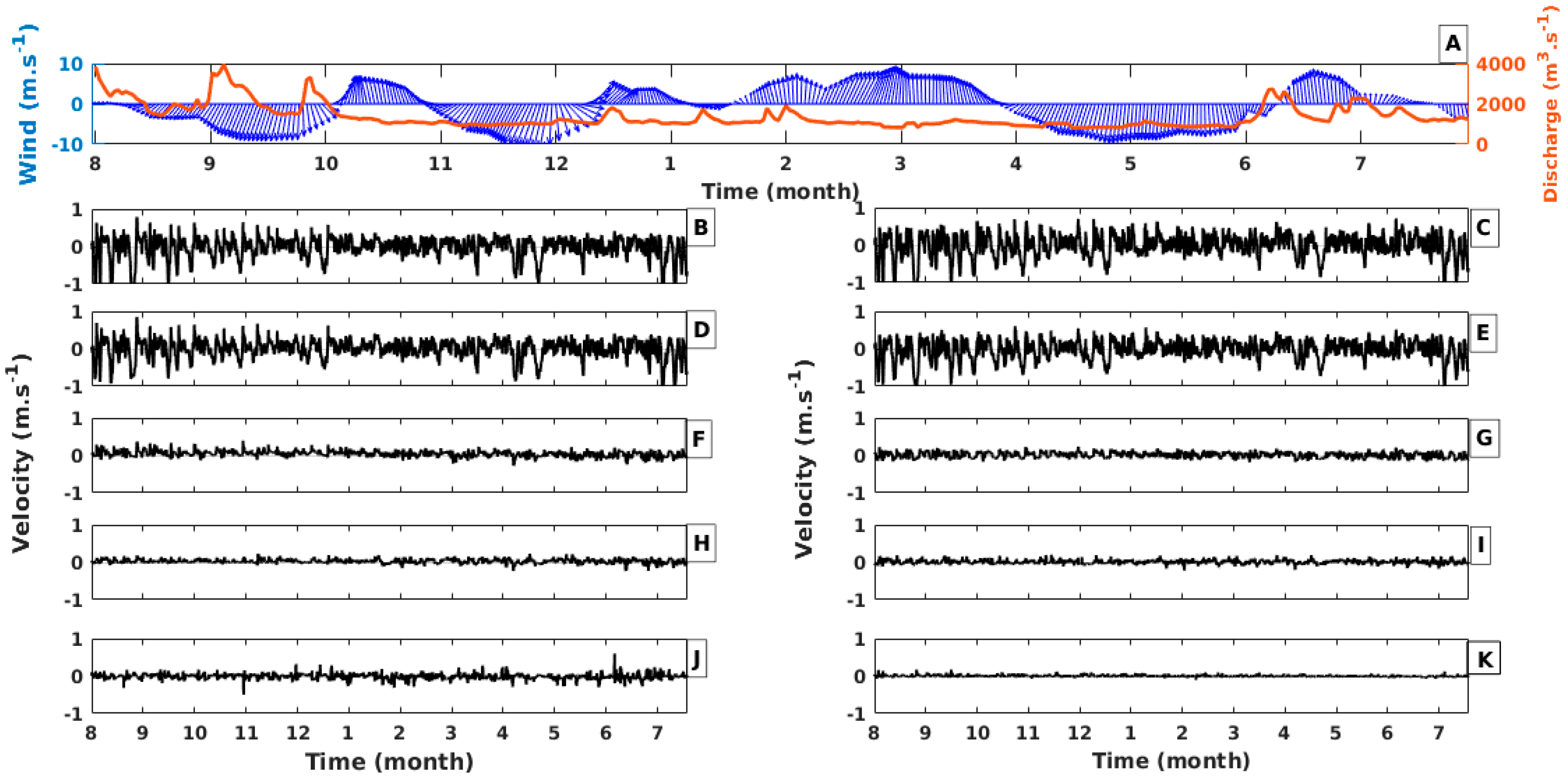
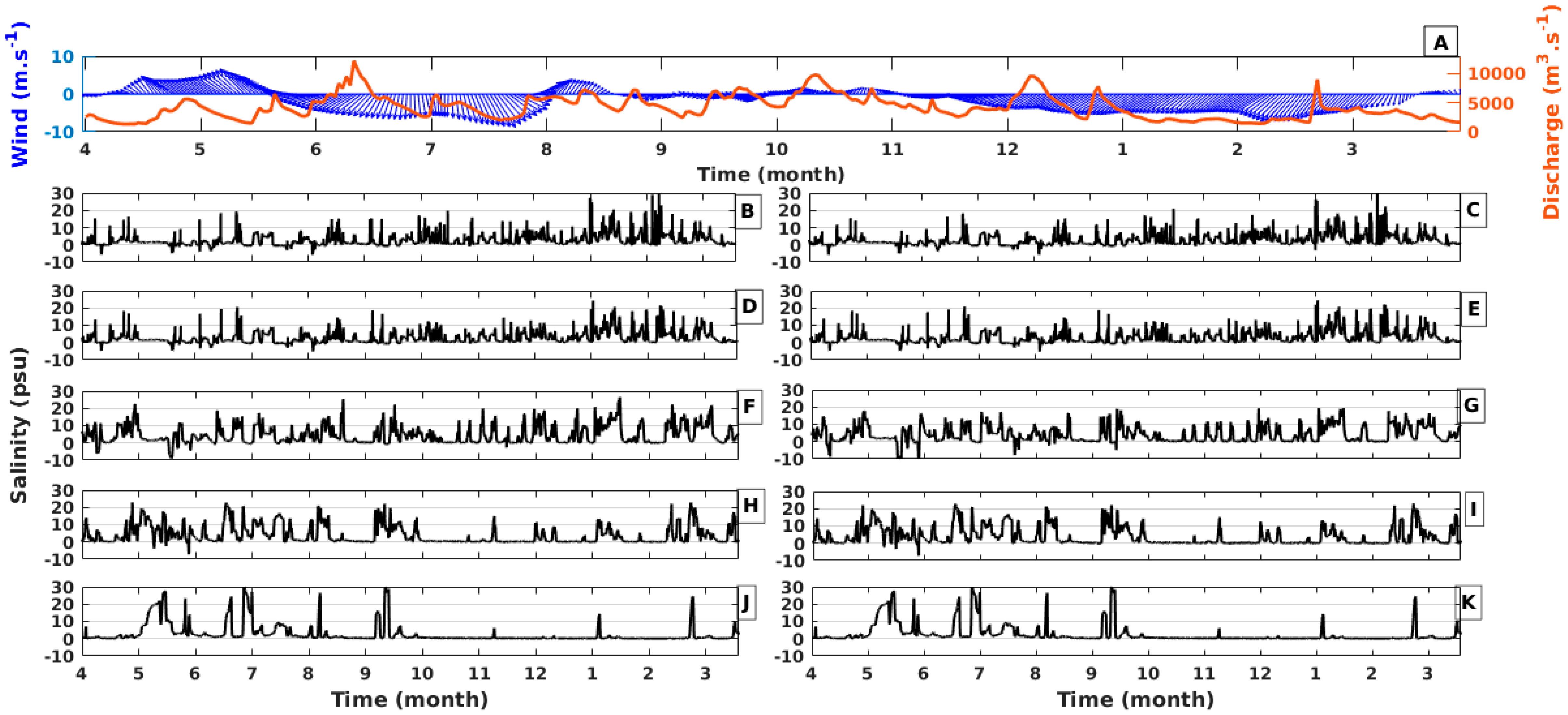
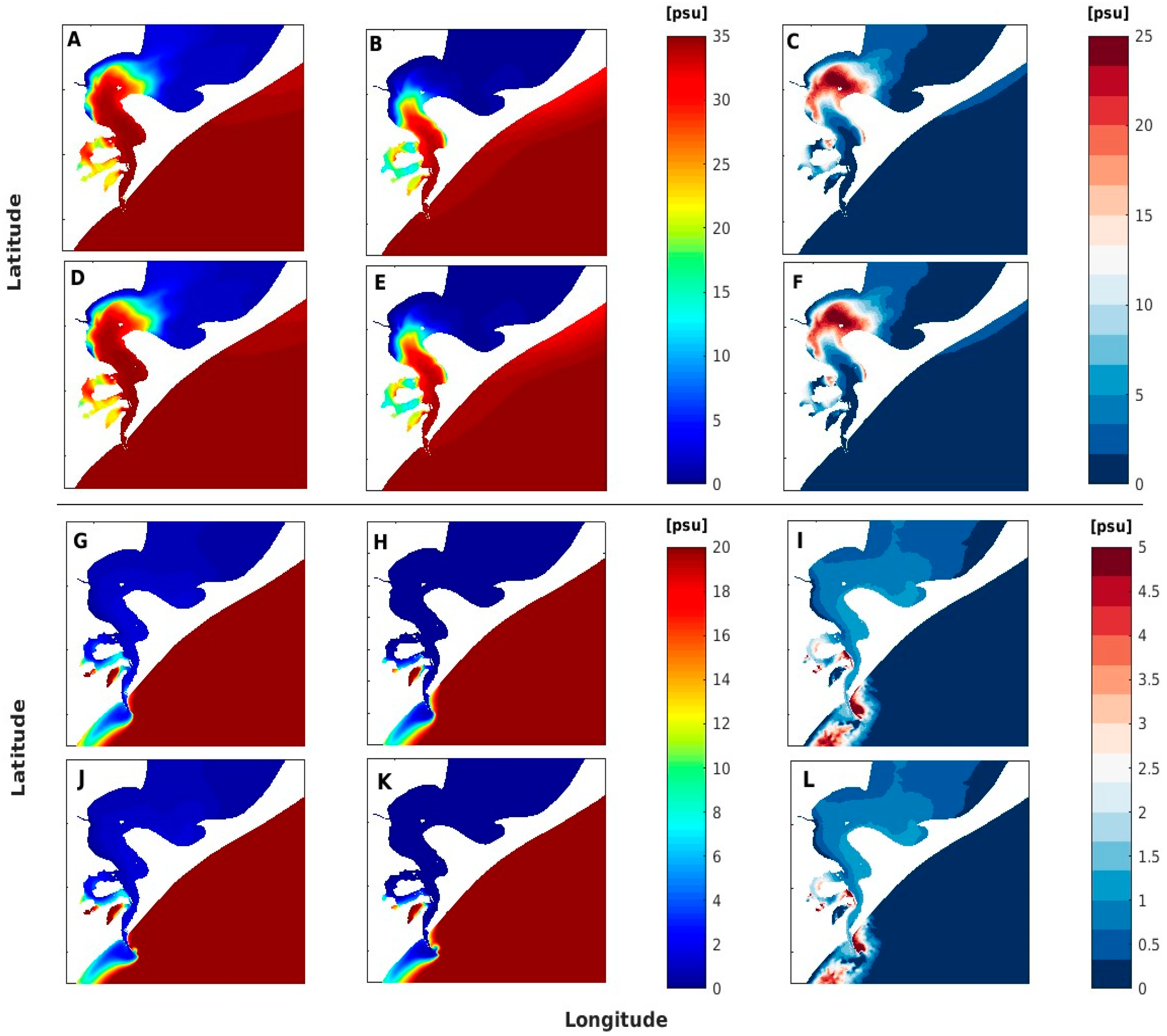
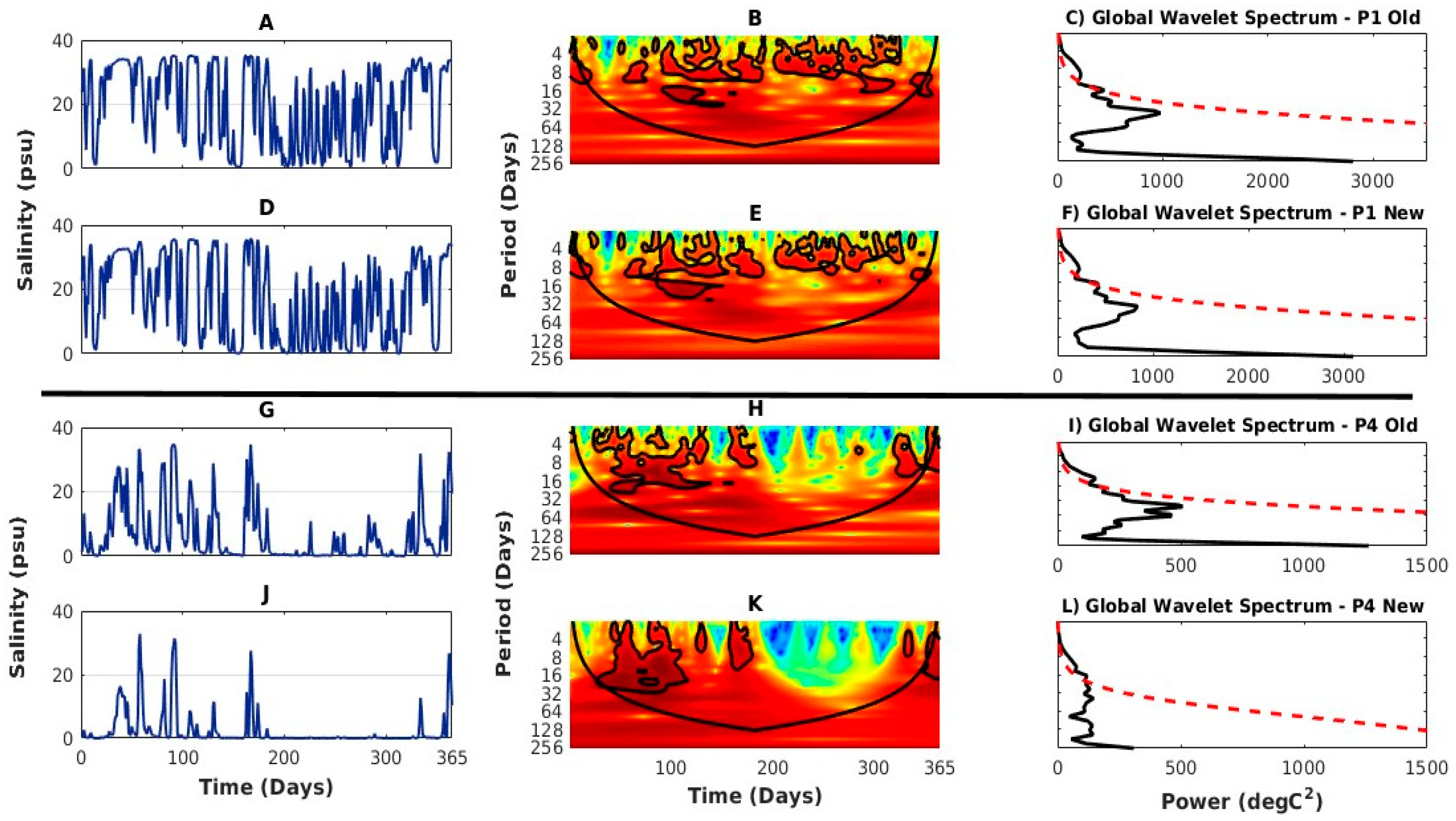
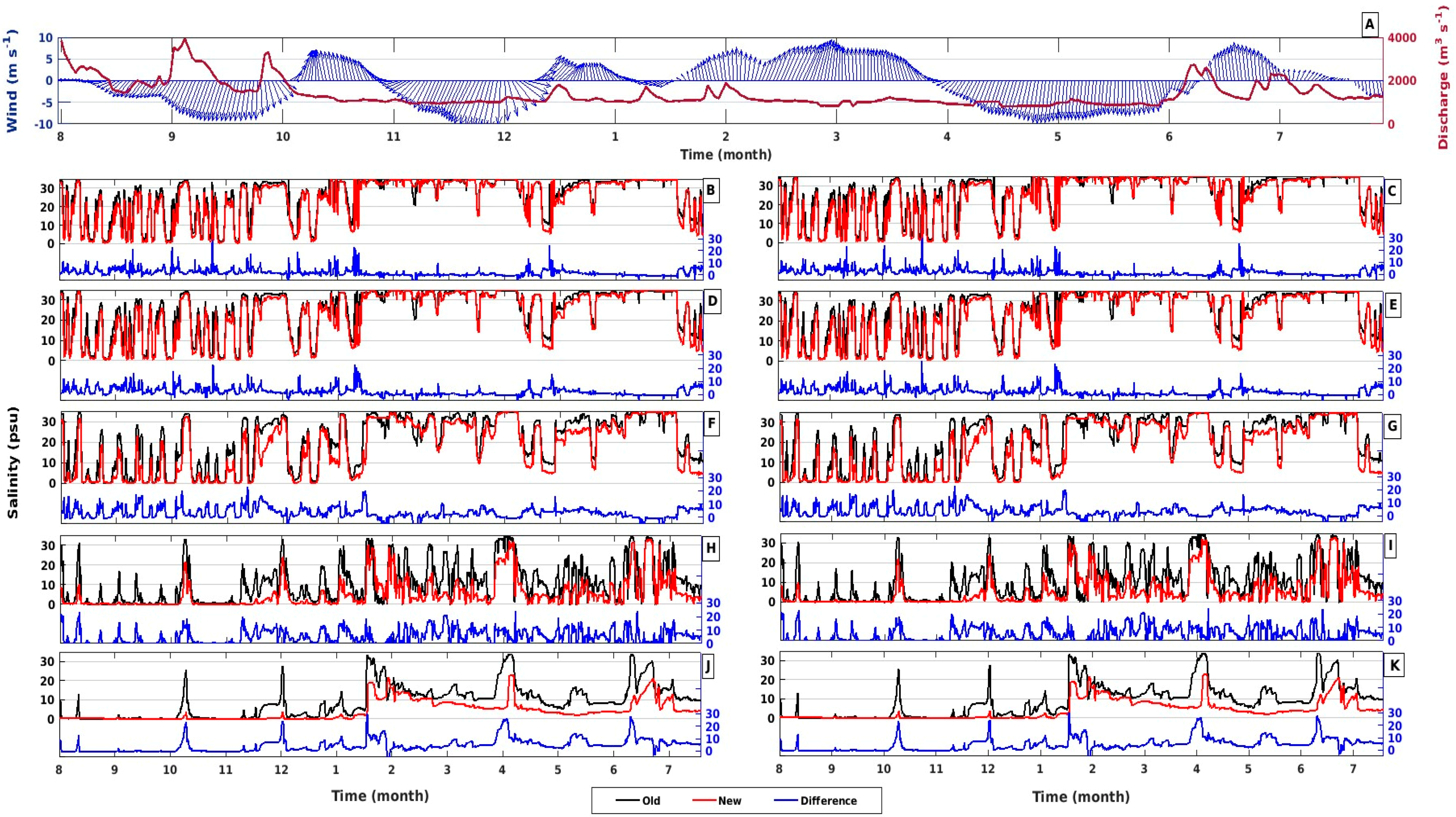
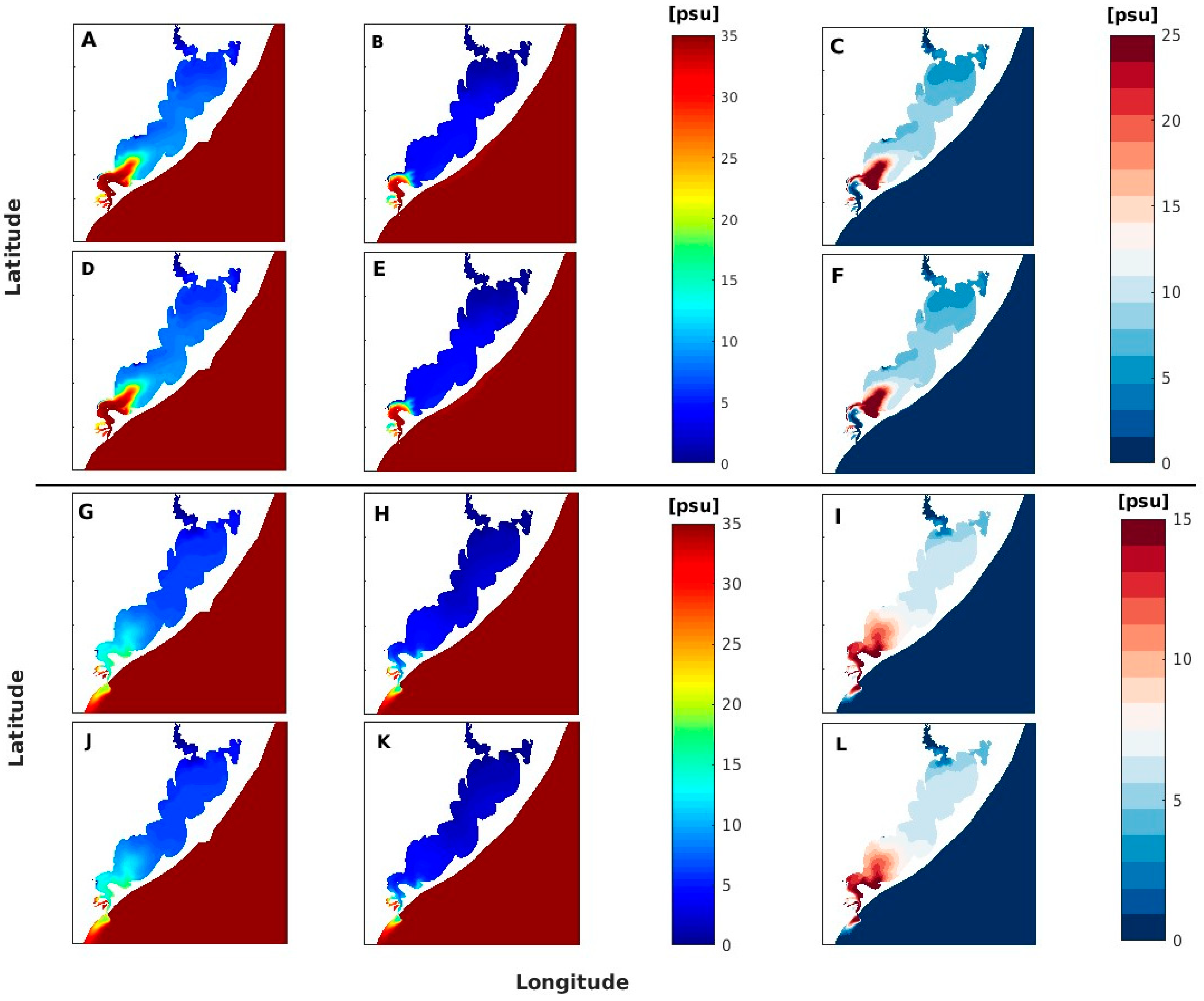
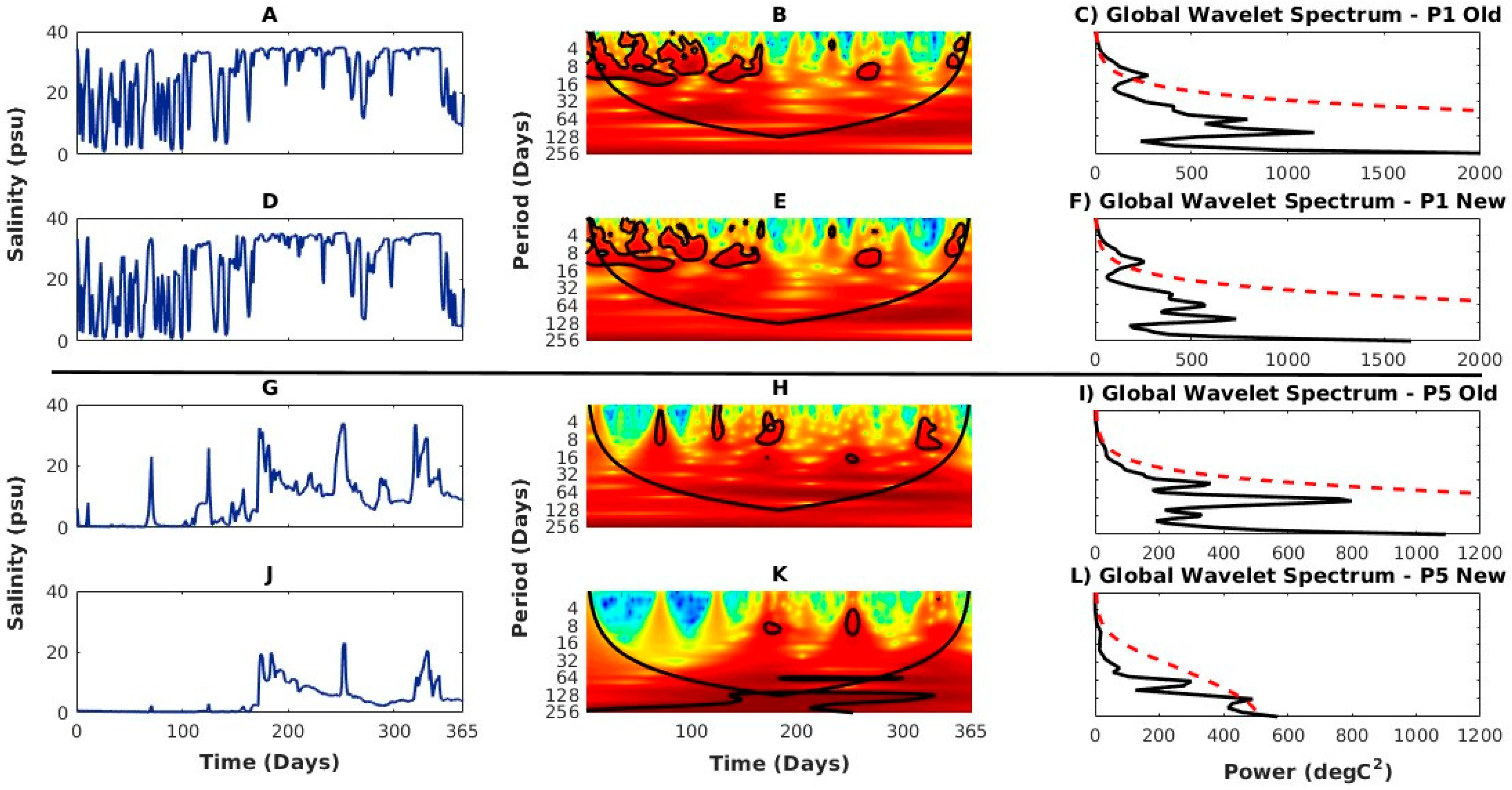
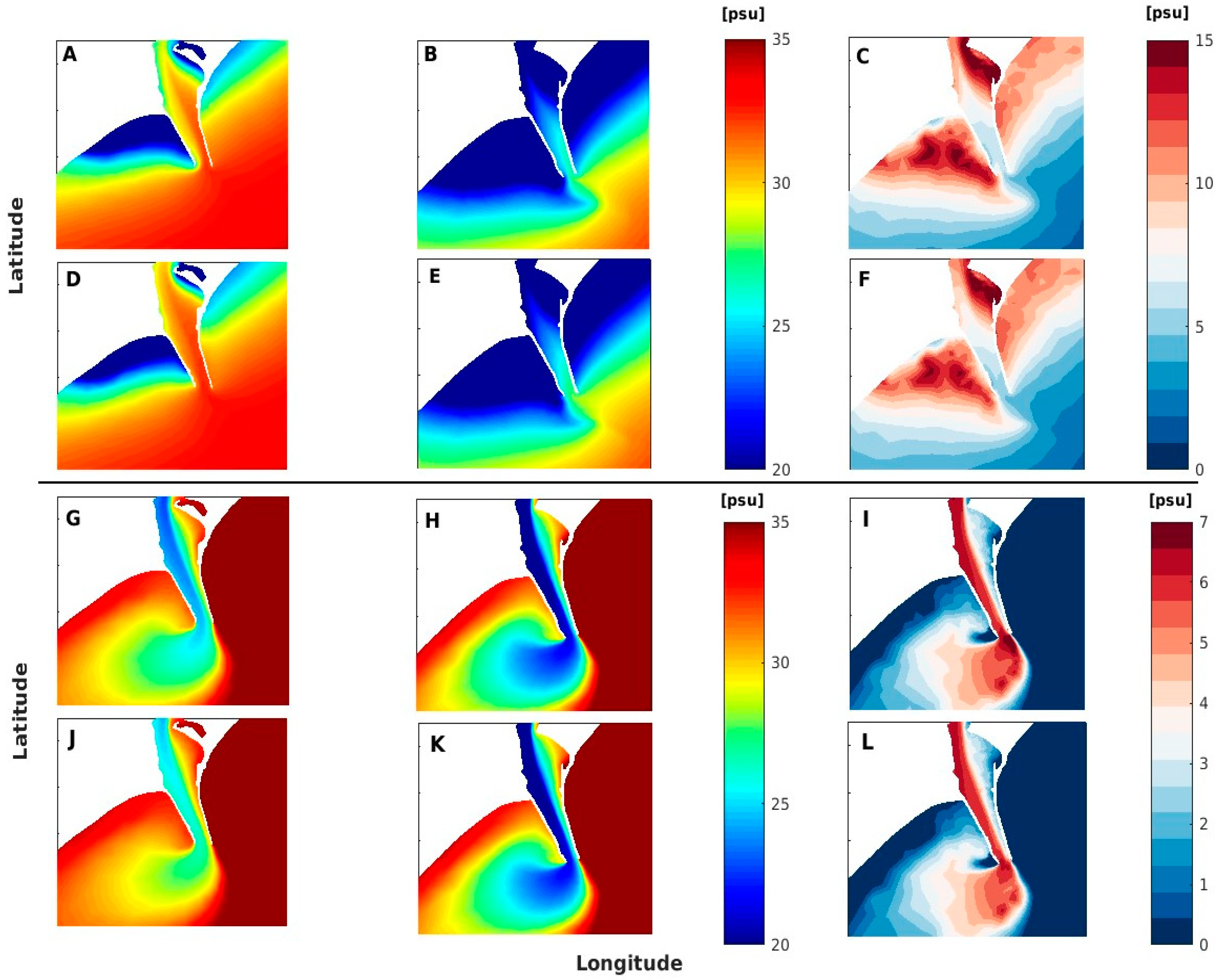
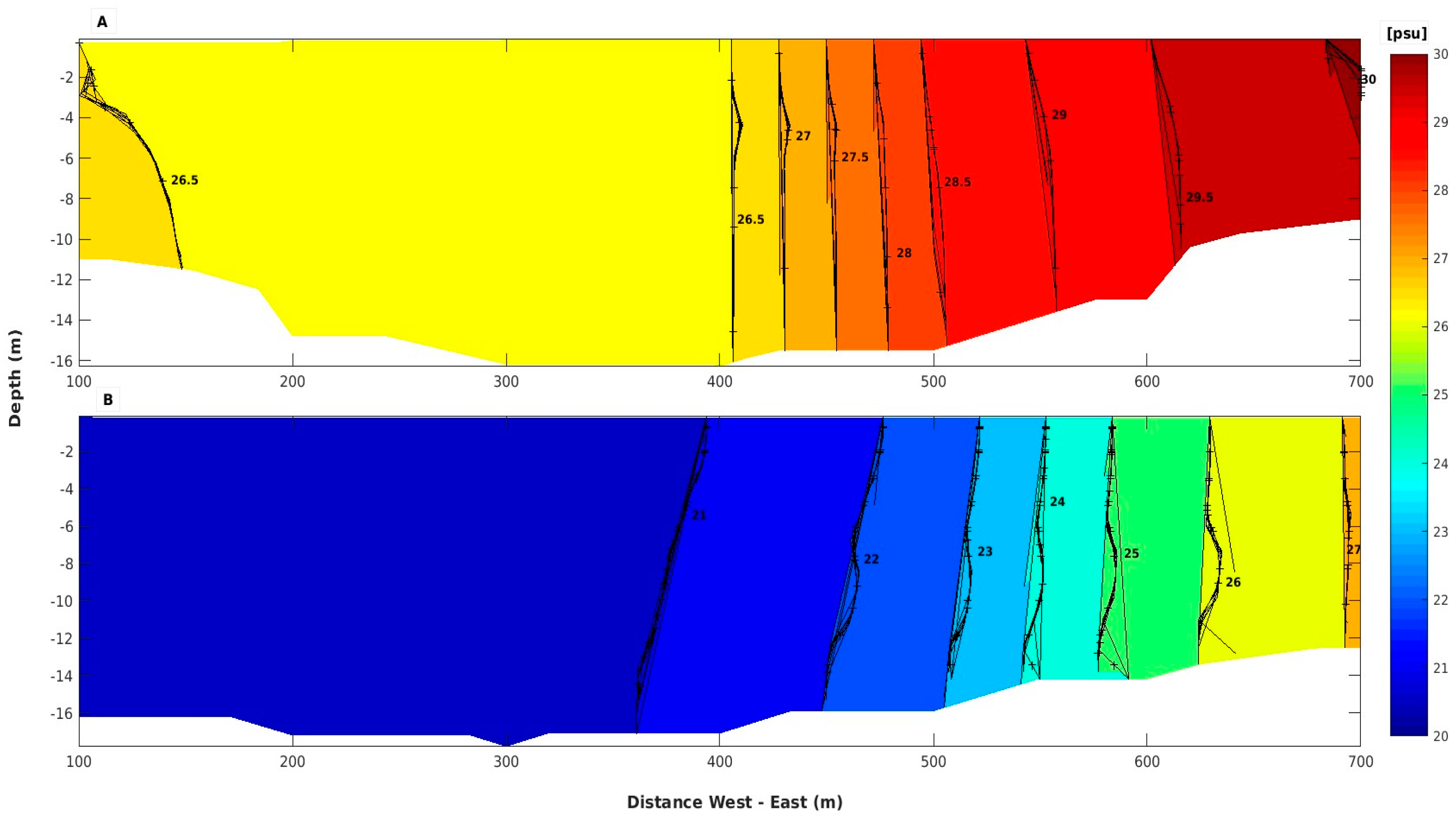
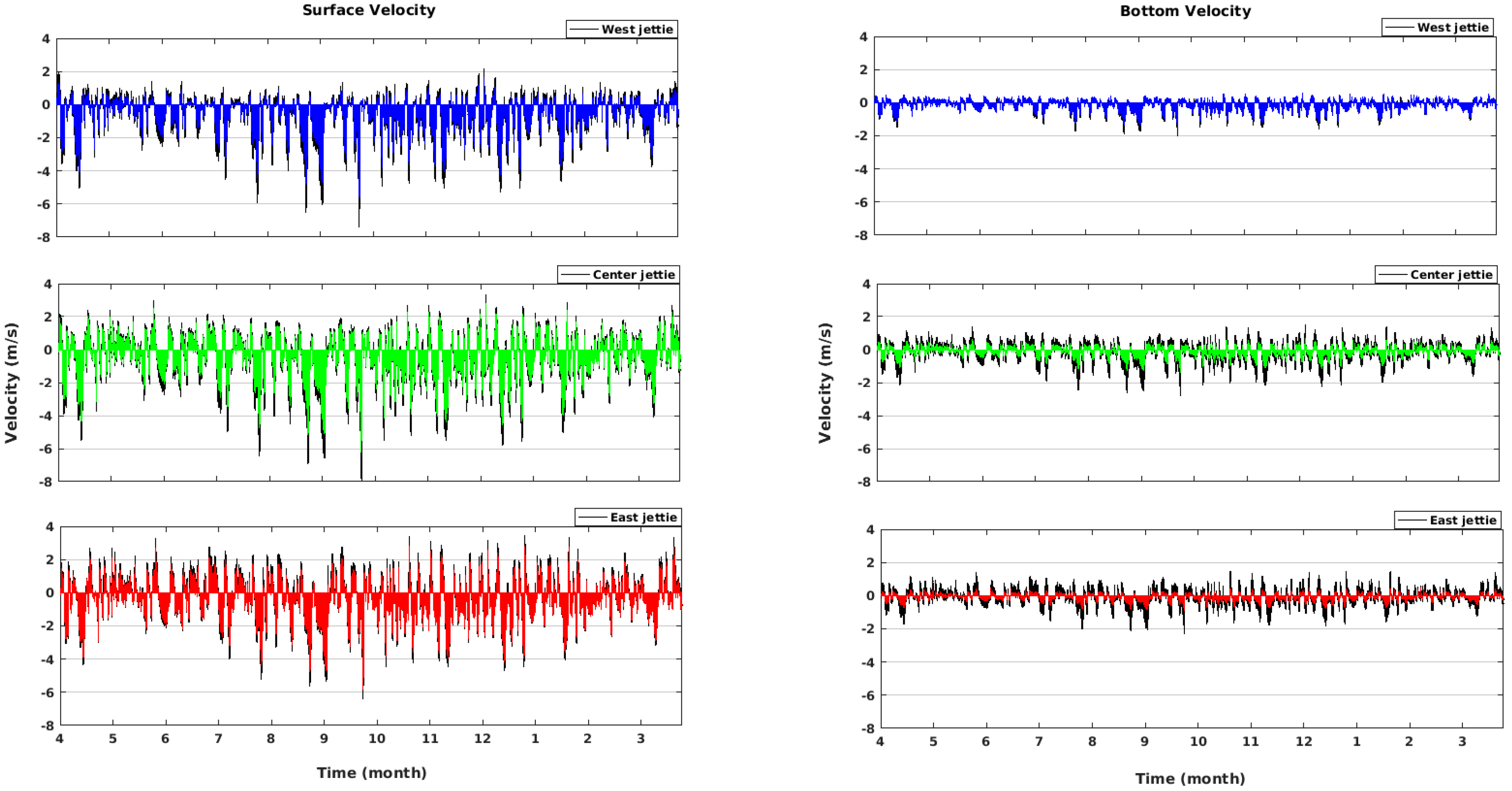
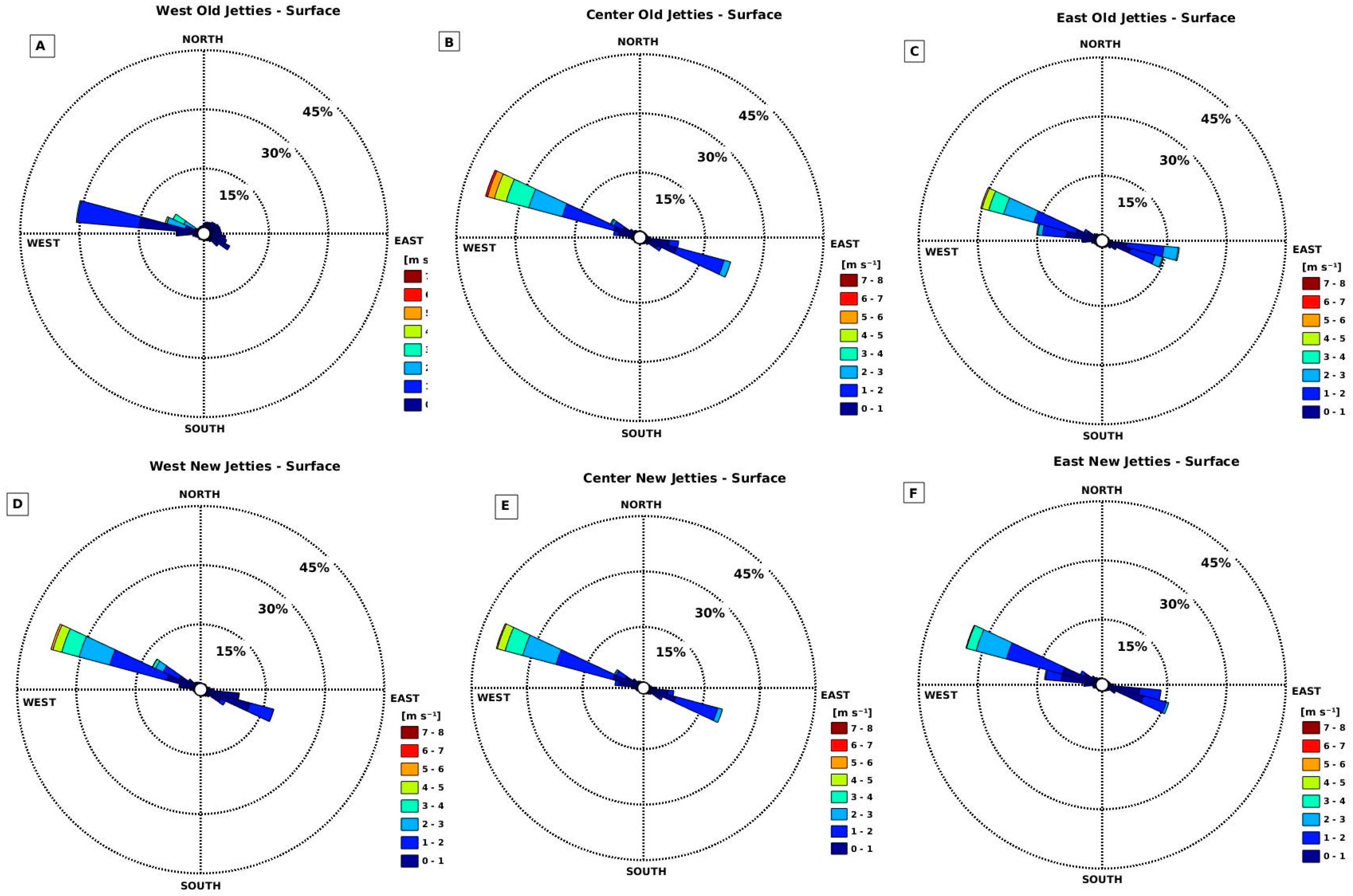
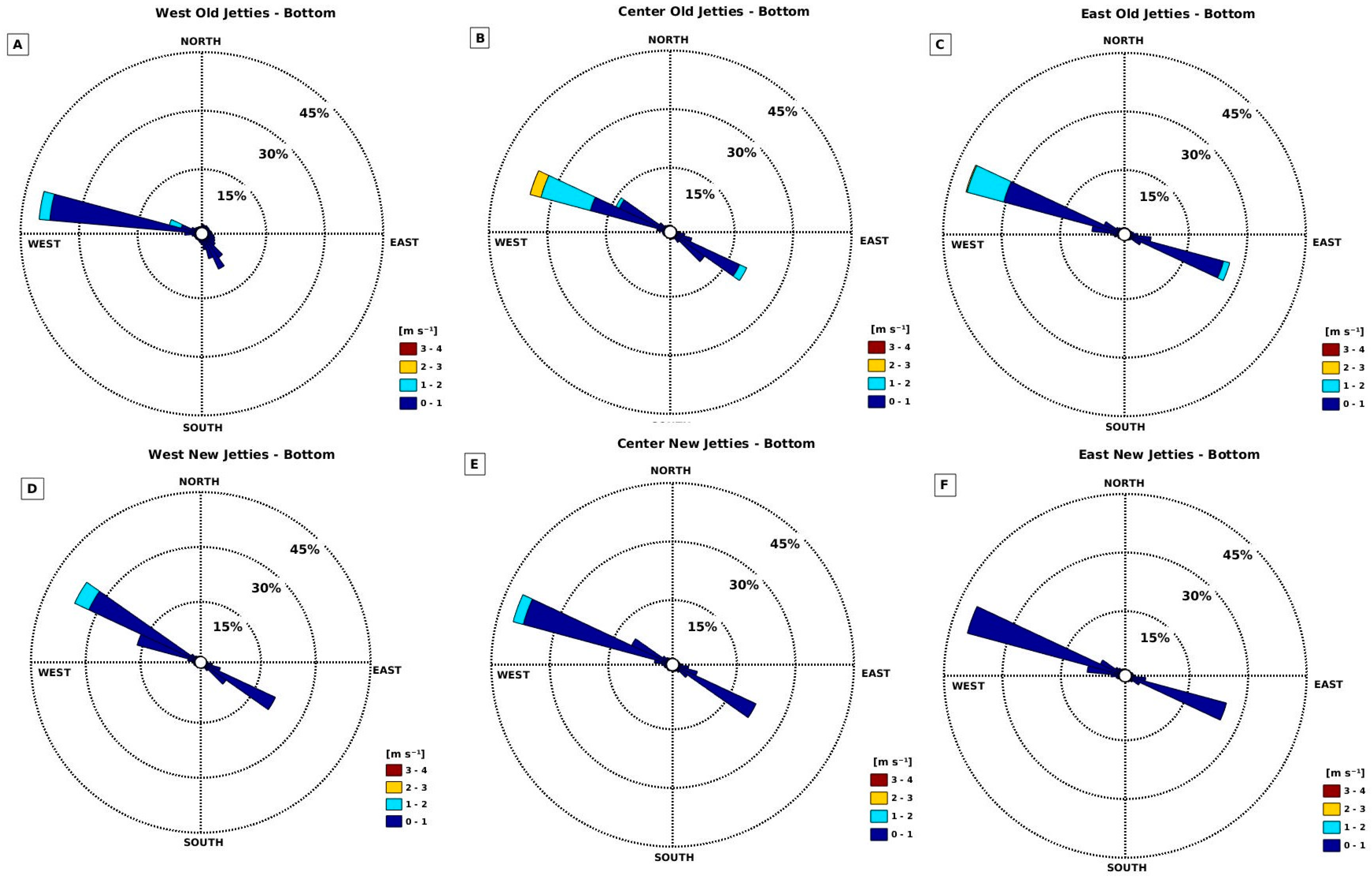
| Parameters | Position | Old Configuration | New Configuration |
|---|---|---|---|
| RMAE | RMAE | ||
| Velocity | Surface | 0.17 | - |
| Bottom | 0.18 | - | |
| Salinity | Surface | 0.06 | 0.09 |
| Bottom | 0.30 | 0.05 | |
| Elevation | E1 | 0.02 | 0.014 |
| E2 | 0.08 | 0.03 | |
| E1 | 0.27 | 0.16 |
Publisher’s Note: MDPI stays neutral with regard to jurisdictional claims in published maps and institutional affiliations. |
© 2020 by the authors. Licensee MDPI, Basel, Switzerland. This article is an open access article distributed under the terms and conditions of the Creative Commons Attribution (CC BY) license (http://creativecommons.org/licenses/by/4.0/).
Share and Cite
António, M.H.P.; Fernandes, E.H.; Muelbert, J.H. Impact of Jetty Configuration Changes on the Hydrodynamics of the Subtropical Patos Lagoon Estuary, Brazil. Water 2020, 12, 3197. https://doi.org/10.3390/w12113197
António MHP, Fernandes EH, Muelbert JH. Impact of Jetty Configuration Changes on the Hydrodynamics of the Subtropical Patos Lagoon Estuary, Brazil. Water. 2020; 12(11):3197. https://doi.org/10.3390/w12113197
Chicago/Turabian StyleAntónio, Maria Helena Paulo, Elisa H. Fernandes, and Jose H Muelbert. 2020. "Impact of Jetty Configuration Changes on the Hydrodynamics of the Subtropical Patos Lagoon Estuary, Brazil" Water 12, no. 11: 3197. https://doi.org/10.3390/w12113197
APA StyleAntónio, M. H. P., Fernandes, E. H., & Muelbert, J. H. (2020). Impact of Jetty Configuration Changes on the Hydrodynamics of the Subtropical Patos Lagoon Estuary, Brazil. Water, 12(11), 3197. https://doi.org/10.3390/w12113197





